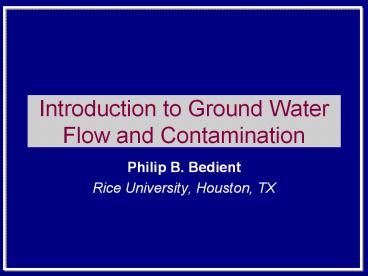Introduction%20to%20Ground%20Water%20Flow%20and%20Contamination PowerPoint PPT Presentation
Title: Introduction%20to%20Ground%20Water%20Flow%20and%20Contamination
1
Introduction to Ground Water Flow and
Contamination
- Philip B. Bedient
- Rice University, Houston, TX
2
Vertical Distribution of GW
3
Vertical Zones of Subsurface Water
- Soil water zone extends from the ground surface
down through the major root zone, varies with
soil type and vegetation but is usually a few
feet in thickness - Vadose zone (unsaturated zone) extends from the
surface to the water table through the root zone,
intermediate zone, and the capillary zone - Capillary zone extends from the water table up
to the limit of capillary rise, which varies
inversely with the pore size of the soil and
directly with the surface tension
4
Porosity
Water
5
Soil Classification Based on Particle Size(after
Morris and Johnson)
Material Particle Size, mm
Clay lt0.004
Silt 0.004 - 0.062
Very fine sand 0.062 - 0.125
Fine sand 0.125 - 0.25
Medium sand 0.25 - 0.5
Coarse sand 0.5 - 1.0
6
Darcys Law
V - K dh/dl Q - KA dh/dl
7
Aquifer Systems
8
Ground Water Use in the U.S.A.
Waste Sites
9
U.S. Ground Water Regions
10
Contamination and Remediation
- Advective transport
- Diffusion and dispersion
- Volatilization
- Adsorption
- Biodegradation processes
- Chemical Reaction
- NAPLs
- Remediation Processes
11
Sources of Contamination
- Industrial spills and leaks
- Surface impoundments
- Storage tanks and pipes
- Landfills
- Burial areas and dumps
- Injection wells
12
Areas of Industrial Contamination
- Surface soils
- Subsurface soils
- Shallow ground water
- Deep ground water
- Vapors above water table
- Drinking water wells
- Receiving streams/lakes
Shallow
Deep
13
Contamination of Ground Water
14
Typical Leaking UST - BTEX
Tank
Floats on water table
Soluble Plume
15
Typical DNAPL Spill Zone
Sinks to lower layer
16
DNAPL Our Most Difficult Challenge
- DNAPL source
- Residual phase
- Trapped on lenses
- Pools in low areas
- Creates soluble plumes for years
- Extremely hard to remediate
17
Typical Industrial Site
Source
- Buried fuel tanks
- Above ground chem tanks
- Ponds and Impoundments
- Buried drums (older)
- Landfill area (hidden)
- Waste process area
- Receiving streams/lakes
- Nearby residential area
Plume
18
Typical Contaminated Site
19
Objectives of a Field Site Study
Monitoring Well Location
- Evaluate
- Surface soils
- Subsurface soils
- Shallow ground water
- Deep ground water
- Vapors in subsurface
- Drinking water wells
- Receiving streams/lakes
Contour Lines
20
AMOCO REFINERY
21
AMOCO REFINERY
22
AMOCO REFINERY
23
AMOCO REFINERY
24
3D-View Topography Max Benzene Tanks
25
The Major Aquifers of Texas
26
The Edwards Group
27
Chlorinated Solvents
28
Chlorinated Solvents (cont)
29
BTEX-Related Compounds

